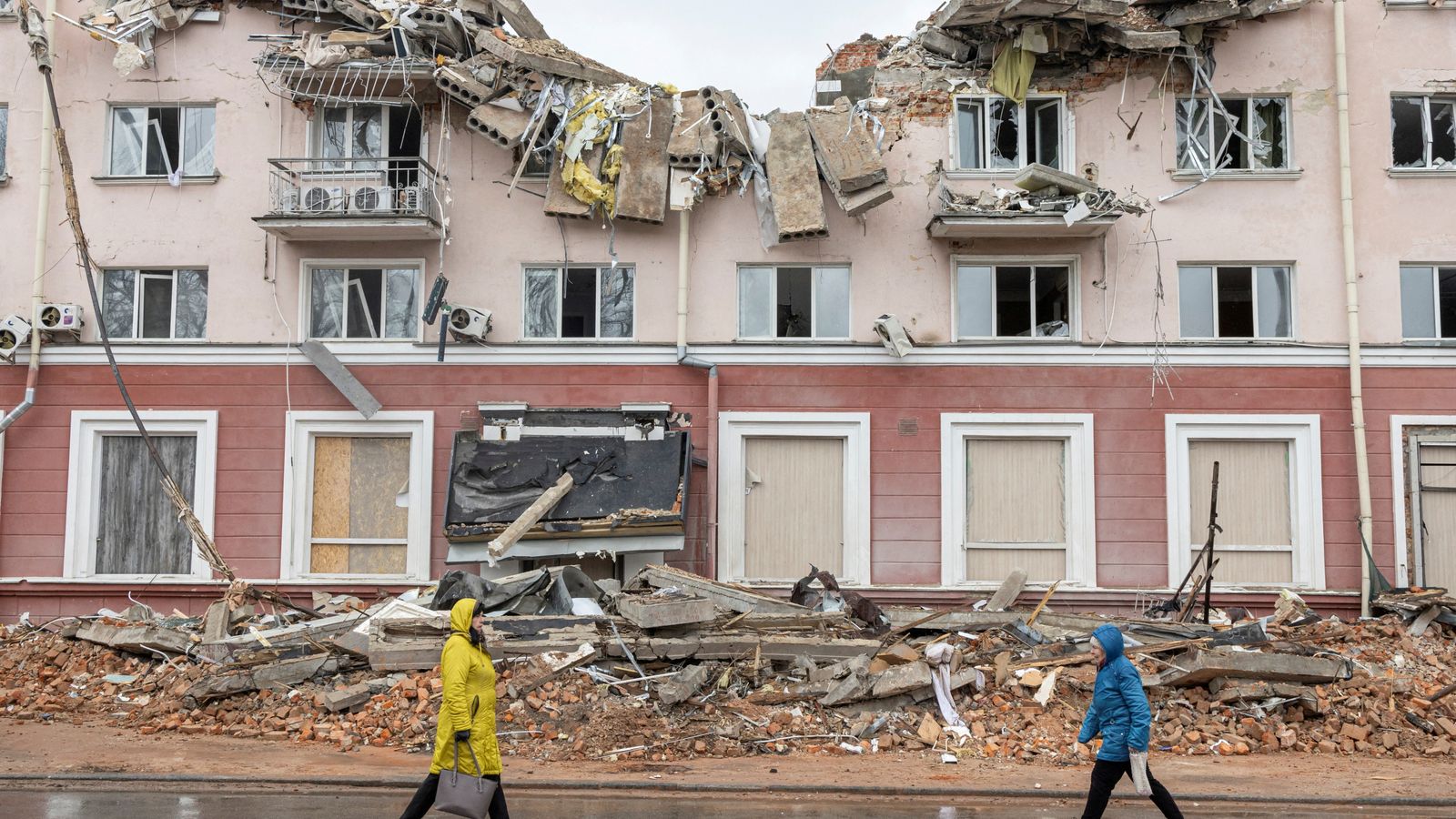Russian shelling shattered the body of a Ukrainian grandmother.
Antonina Budnyk, 60, lost a leg, an eye, some fingers – but not her spirit.
Lying in a hospital bed in the northern city of Chernihiv, she said: “I think will be OK. I will be healthy again. I will dance! And Ukraine will be the best country!”
Ukraine war live updates: Putin will ‘re-focus ambitions and be ready to negotiate’
Please use Chrome browser for a more accessible video player
She is one of hundreds of victims left dead or injured after Russian tanks tried but failed to seize this city, which stands close to Ukraine’s border with Russia and Belarus.
It suffered weeks of heavy bombardments before Russian forces retreated a few days ago, lifting a siege that had forced residents to cower at home and in hospitals.
They had limited chances to escape, even those with life-threatening injuries.
Ukraine war: Putin has ‘achieved zero’ and Ukraine can ‘absolutely’ win, says US
Ukraine news live: ‘There are so few of us’ – Russian soldiers complain in intercepted radio message
Ukraine war: The saviour of Mariupol – how fearless mechanic rescued 180 people in besieged city
On Wednesday, though, there was traffic once again on roads in and out of Chernihiv.
Surrounding bridges, destroyed in the fighting, have been patched over with makeshift planks, allowing cars, vans and even lorries precariously to gain access.
Chernihiv is the largest Ukrainian city to be freed after being besieged.
Residents here hope the fighting will not return, but Russian troops have merely pulled back across the border and stopped firing rather than dispersed completely.
In the main hospital, doctors described how they had to perform operations in the basement using torchlight during the worst days of the onslaught.
“There was massive shelling,” said Valery, medical director of the Chernihiv Clinical Hospital. “Our hospital was shelled too… So we had to work under such difficult circumstances, to help people – civilians and soldiers, and unfortunately children too.”
He described how on a single day, within the space of about two hours, the hospital received more than 50 patients with devastating blast injuries.
Please use Chrome browser for a more accessible video player
Doctors have collected much of the shrapnel taken from people’s bodies. Each piece of twisted, jagged metal and glass is kept in a clear plastic bag, with the name of the patient it was taken from written on it.
One of the pieces, about the size of a marble, was from a cluster bomb, a medic said. It still had bloodied human hair still attached to it.
This hospital has treated about 600 patients, 60% of them – some 360 – civilians and the rest soldiers since the fighting started.
In a small ward was Antonina, who lost her right leg, right eye and some fingers when Russian shelling hit her house on 22 March.
She had been inside with her disabled mother at the time.
They had tried to shelter in the basement, but the round struck just as Antonina was shutting the door.
“It felt as though a bell hit my head,” she said, describing the impact of the blast.
She realised her right leg had been ripped off but rather than panicking she grabbed a piece of rope to wrap around the remaining stump and stem the flow of blood.
Her mother, who had been deeper in the basement, survived relatively unharmed.
“When the soldiers came, they helped me. It was… fast. But I was not in shock. I understand that it is a war.”
Read more: Putin has ‘achieved zero’ and Ukraine can ‘absolutely’ win war, says US
Despite suffering such catastrophic injuries, Antonina, a round-faced woman with an easy smile, cracked jokes with her rescuers about her weight.
“When our soldiers carried me, I was joking – because I feel fat – and said do them: ‘Guys, now I become a bit lighter'”.
She has had darker moments, though.
Antonina, who worked as a street cleaner before the invasion, said she cried the first time she heard the voices of her four adult children. She also has three grandchildren.
They had spent three days not knowing what had happened to their mother.
“But in general, I am very optimistic,” she said, speaking in a seated position from her hospital bed by holding onto a bar that runs above in.
A blue-coloured bandage covers the stump where her right leg had been, a jagged cut runs across the sunken eyelid over her lost eye and several of her fingers are bandaged.
But she is still filled with a vibrant energy.
“If God has gave me a second chance, then everything will be ok,” she said.
“I will see my city, happy and rebuilt, people will come back. I really want it. I will see it.”
Life is cautiously returning to the streets, with banks and pharmacies reopening.
In the city centre, it feels calm, though evidence of the war is not hard to find.
A hotel has been pulverised by an airstrike and the main post office damaged.
Officials said hospitals were also hit.
Russian forces never managed to penetrate the heart of the city despite targeting it from the first days of the invasion, which began on 24 February.
But the outskirts and surrounding villages suffered merciless bombardments and were surrounded by Russian troops.
The top local government official said he had seen evidence of torture and of civilians being deliberately killed – as happened in the town of Bucha, close to Kyiv.
Follow the Daily podcast on Apple Podcasts, Google Podcasts, Spotify, Spreaker
“Russian tanks were standing in these villages, and in backyards of houses,” Viacheslav Tchaus, head of Chernihiv region administration, told Sky News.
“Residents had to live in basements. There were a lot of cases of tortures, killings of civilians. It is near Chernihiv city and around the Chernihiv region.”
He said the total number of confirmed civilian deaths from the war across the region was 300 but feared that number would grow as the authorities check buildings and houses.
The total number of civilians injured is at more than 1,000 but that could also rise.
Asked whether he thought Russian forces might target his region again, Mr Tchaus said: “I hear for a couple of days that the war in Chernihiv is over, but it is not. I think while a single Russian soldier is still in Ukraine, the war is also still here, and in Chernihiv too.”







